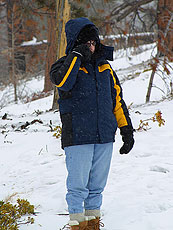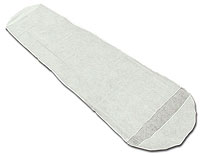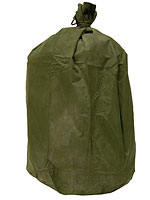
Cold weather camping is an enjoyable family adventure
Labor Day is the traditional signal for the end of camping season for most families. We tend to equate camping with sunny summer days by the lake or beach and, let’s face it, by the end of September warm sunny days are getting fewer and far between for many of us.
Winter camping offers many advantages, though, including the fact that all of those “other†campers are staying at home and not crowding your campground! The trails are still there, the fish are still biting, and the peaceful winter calm will make you wonder why you didn’t start extending your family camping season earlier.
Unless you plan on camping in extremely cold locations or at high elevations, your regular camping gear is probably just fine for winter camping. If you have been reading CampingBlogger, you know that I’m no fan of cheap “superstore” gear, so in this context “regular camping gear” means a good, 3-season tent, and 20-degree sleeping bags.

Cocoon sleeping bag liner, from Design Salt
Though I’m a big advocate of paying for good quality gear, the additional cost of 4-season tents and lower-rated sleeping bags does not make a lot of sense, for us. A sleeping bag rated for 20-degrees can generally be used all year long, whereas the lower-rated bags are just too warm for much of the year. You can always add a sleeping bag liner, like the very good Cocoon® products, for additional warmth.
The key to comfortable cold weather camping is, of course, keeping warm. Moisture is your enemy in cold weather, robbing your clothes and sleeping bag of their ability to insulate. Keeping dry is critical, which is the real reason behind layering; not piling-on additional clothes to stay warm. Layering allows you to easily shed clothes to control your perspiration.

An inexpensive military surplus waterproof bag over the end of a sleeping bag can add additional warmth
Our feet in particular, perspire a lot, so it is important to change socks often and always before turning in for the night, less you suffer through the night with frosty toes! If you still have problems with cold feet at night, you can place a waterproof backpack liner over the end of your sleeping bag, and it will keep your feet much warmer. For a fraction of the price, a military surplus waterproof bag works just as well.
Likewise, at the other end of your body, a knit cap over your head will keep you warm and is a much better solution than burying your head inside the sleeping bag, where much of the moisture from your breathing will be trapped. This is an important lesson to teach, and reinforce, to your children, since our natural inclination is to cocoon inside the sleeping bag.
Condensation inside the tent can be a big problem in the winter, so even though it sounds counterintuitive, it is important to ventilate the tent well. This is where spending the extra money for a good tent provides a real benefit, as they generally have full-coverage rain flies that come all the way down to the ground.
The layer of air between the tent and rain fly will provide some insulation, yet the moisture from all of that snoring will travel out through the vents in the tent and condense on the underside of the rain fly, which is a lot better than on the inside of the tent.
Winter camping is an enjoyable family activity that does not require a bunch of new, expensive, gear. Next time, I’ll talk more about winter camping activities that your family can enjoy, but just to recap the first part in this series:
- Your tent should have plenty of ventilation and a full rain fly
- A sleeping bag liner can provide additional comfort
- If you have a problem with cold feet at night, place a waterproof gear bag over the end of the sleeping bag
- Layer clothing to control perspiration
- Dry feet are warm feet, so change socks early and often
What are some of your tips for keeping warm and dry in the winter?
See also…

Good Info. I also am a firm believer in quality gear. No time for failure of equipment in cold weather.
Any recommendations on propane heaters for cold weather camping? Which are safe and affordable?
Russ – the safest is something like the Zodi, where all combustion takes place outside the tent and the heat comes in through ducts:
http://zodi.com/web-content/Consumer/zodihotvent.html
Of course, lots of people use the Buddy Heaters:
http://www.mrheater.com/product.aspx?catid=41&id=338
Regardless of which direction you go, heaters increase the conditions for condensation to occur inside your tent, so make sure you keep it well vented. It’s no fun to wake up all wet in the morning!
Your comments about a knit cap can bear repeating, Roy. In cold weather it can’t be stressed enough to cover your topknot.
Your body is a furnace who’s one function is to keep the brain warm. It will happily let other parts—like extremities—freeze so long as it can direct heat to the head.
As we used to say on the winter backpacking trails, if your hands are cold, put on your hat.
Likewise your tips about staying dry. Personally, I’m always amazed at the number of folks who do not understand thermal control, and how sweating can be one of the most dangerous things outdoors. Hyperthermia lurks behind every bush and tree. And it’s moisture that leads to it, more times than not.
Brook
http://www.the-outdoor-sports-advisor.com
Brook’s last blog post..Jan 4, Grouse Hunting: Down East Wings of Thunder
Roy, I also carry a good Rangefinder as well as my Night vision optics. Out west where I go, it’s nice to see the bears and coyotes and sometimes the lone wolf stalking around nearby. Just be alert and have some form of conveyance to deter the animals from getting too close.
And it bothers me, being a retired geologist/paleontologist/archaeologist letting the oil compnaes have maybe access to places where the oil companies, no matter how well they ‘think’ they will protect the area, they don’t always. And having been a field geologist working the Big Horn Basin and around TenSleep, Wyoming, I’ve seen what environmental protection they provide. Yeah right! Good articles you and others’ put on your site Roy. Kuddo’s brother
Another great site – very nice, Jim! Tons of good advice on your Winter Camping Tips page. In encourage everyone to check that out.
I also added a link over at http://huskyhiker.com, I’ve been meaning to do this for a couple days now…
Jim Bradley’s last blog post..Bare Mountain to Military Rd. loop trail – 4.3 Miles
Pingback: » Cold Weather Blogging
John – I refer you to the WinterCampers.com web site which has a recommended gear lists for winter camping, a beginners guide, leave no trace suggestions for winter camping, trip reports and photographs and winter camping humor. There is even a winter camping blog.
I urge you to check it out.
Jim Muller’s last blog post..Adirondack International Mountainfest
Roy, I’ve always followed the knit cap when sleeping suggestion. It’s also a great one for backpackers in the summer, because nights at high elevation can dip below freezing.
And I agree about not needing super-warm sleeping bags. You’re camping, so you can always bring a couple of warm blankets to wrap around the bag.
John Soares’s last blog post..Climate Change in Yosemite National Park
Ted – that’s a *great* looking site you got there. Thanks for the link, I appreciate it. I’ve added you also, and will be doing a lot reading tonight.
Jim, those tin foil meals are hard to beat for ease of cooking and ease of cleanup! They got so popular that you can buy pre-made foil pouches, now (I guess I’m old school, I still make my own).
When I was a boy scout we did a fair amount of winter camping. One thing I would always do if make tin foil meals. Like meat and vegis wrapped in tin foil, doing all the prep work at home. That way when dinner time comes you just throw your pouch on some hot coals. Warm wonderful food will be ready before you know it…
Excellent article, I really like your equipment reviews, I am adding a link to this blog on mine: http://www.campingsierra.com
Best Wishes
Ted
Ted’s last blog post..Halfdome early morning